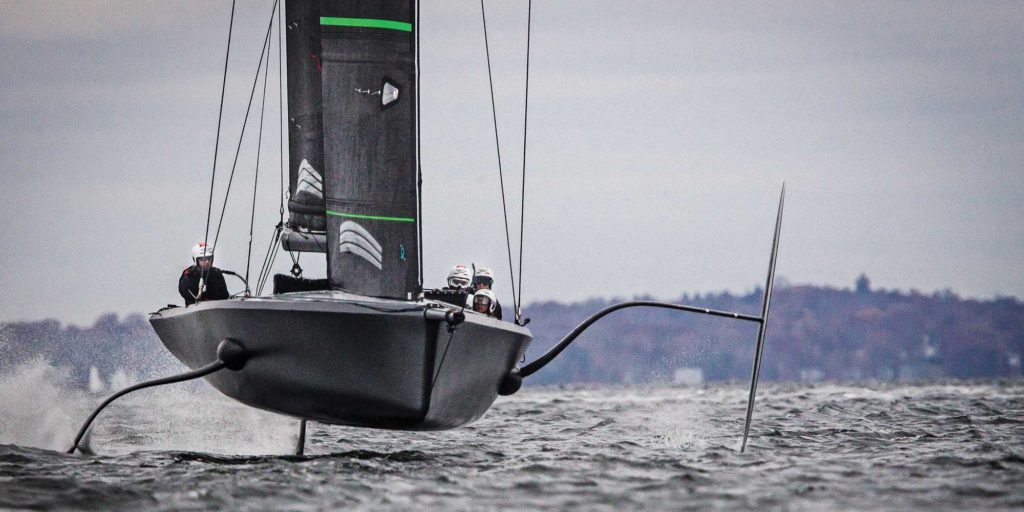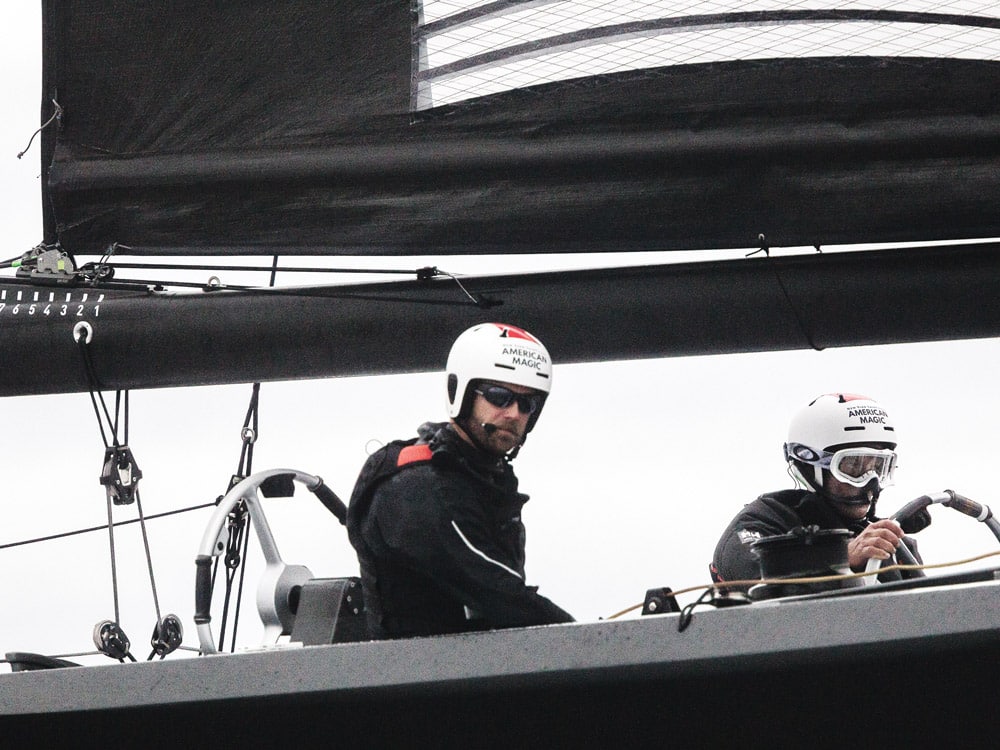
From ghoulies and ghosties
And long-leggedy beasties
And things that go bump in the night,
Good Lord, deliver us!
Launching any new raceboat for the first time is an eerie experience. Creaks and moans, pings and tangs, all the noises of the rig, foils and joints settling into place are reminiscent of the old Scottish poem. But the New York Yacht Club challenge’s American Magic 38, known as the Mule, perhaps fits the rhyme better than most. Its ghostly matte-black hull, ghoulish dark sails and long-legged beastly foils protruding from its topsides and transom do suggest some scary creature. Our pre-dawn boat launch on the eve of Halloween, evading the watchful eyes of Luna Rossa and INEOS Team UK spooks, adds to the supernatural mood as our silent water spider slips into the sea and is soon skittering across Narragansett Bay.
Most of American Magic’s sailors, designers and shore crew involved with the program have experienced America’s Cup foiling classes in some form or another, from San Francisco’s 72-foot giants lurching from the water against the odds to Bermuda’s “dry-lapping” 50s. Plenty of us have had racing experience in foiling monohulls with the Moth class and other dinghies, such as the Nacra 17 and A-class catamaran. Considering how intense our 38-foot test boat is, however, I don’t think any of us are fully prepared for how powerful and raw our full-size AC75 will be. For our team, the otherworldly experience will continue well after the trick-or-treaters have shed their masks and gobbled their candy.
At American Magic, the Mule project has been a test of mettle for our designers, boatbuilders and shore crew. We wanted to get a platform on the water that we could use to validate and sharpen our design tools as we move closer to launching our first big boat in early 2019. The frightening reality of this new era is no longer the speeds involved, but the complexity involved with maintaining the boat’s top performance after possible wipeouts at speed. Capsizing any boat this big is no joke. With previous classes, a capsize was a day-ender. Today, we have to work toward a boat that, if flipped, can get upright and into the second race of the day. The hydraulic and electrical systems necessary to keep us up and running, maneuvering effectively and collecting good data do not like water, or being run upside down.
The Mule is a handful to sail when on the foils, demanding the complete concentration of helm and trim.
The inherent instability of a keel-less monohull means that down-speed maneuvering is extremely risky. We’ve all heard the sailing axiom that “speed is your friend,” and when it comes to this new type of foiling boat, this is categorically true. The Mule is a handful to sail when on the foils, demanding the complete concentration of helm and trim, but the AC75 will depend on the total exertion of human grinders that will provide energy for trimming and maneuvering for the entire race. Being up on the foils, careening toward the nearest boundary or shore, is far and away more comfortable for the sailors than sitting in the water, side-tied to the chase boat during a sail change.

The British challenger, INEOS Team UK, launched its test boat on the Solent in the summer of 2018, and we watched carefully to see what its proof of concept could add to the growing list of design questions surrounding the radical new AC75 concept. Our Mule was already in the works, but watching the British sailors spin out, plunge, crash and turtle their boat on a regular basis gave us pause as we contemplated how we would attack this problem the right way. Their flight controls looked outstanding, enabling them to tack and jibe right away, but other parts of their systems looked rudimentary. It was impressive nonetheless to see the two sailors on board T5 romp around Portsmouth, boldly showing the design concept was going to work. That sight lit a new fire under our team. We knew the Mule was a more ambitious stab into the unknown, but the value was clear as the recon from Britain came forth.
Foiling is not new, but launching and sailing the Mule has opened a can of worms that cannot be put back. We now know the widening expanse of what we do not know. The anxiety of that awareness is not as cozy and warm as the bliss of our ignorance before embarking on this project. So, as we move into the short days and dark nights of winter, we press on, waiting for the bumps in the night that we know will come.









